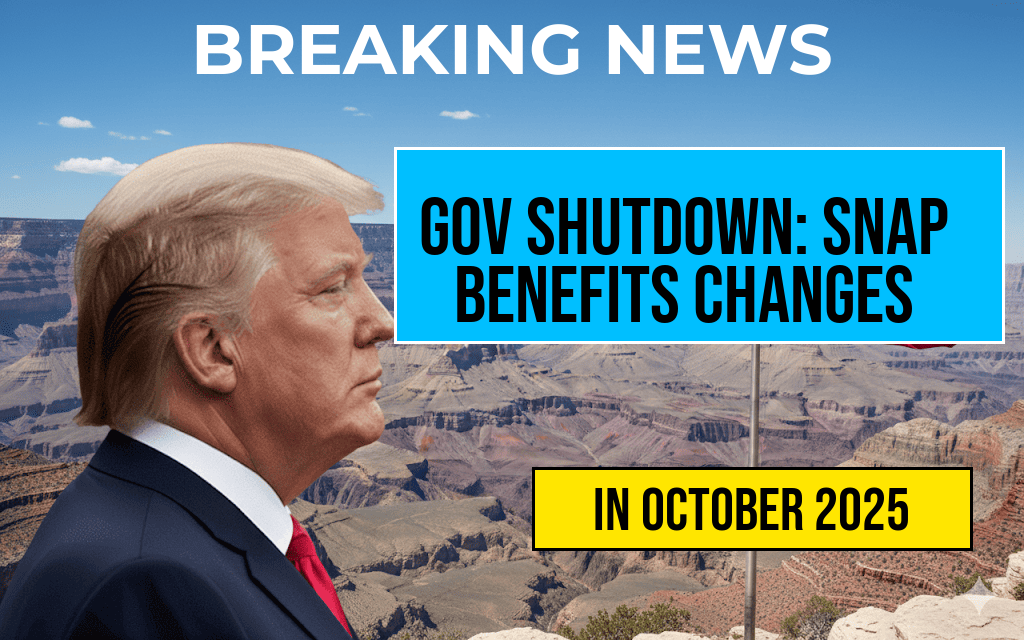A recent federal government shutdown has introduced significant uncertainty for millions of Americans relying on Supplemental Nutrition Assistance Program (SNAP) benefits, commonly known as food stamps. As federal agencies face funding gaps, questions have arisen about how ongoing disruptions may impact benefit distribution, eligibility, and access to food assistance. While some states have contingency plans in place, the potential for delayed payments, reduced benefits, or administrative hurdles could affect vulnerable populations, including low-income families, seniors, and individuals with disabilities. This article explores the current state of SNAP during the shutdown, what specific changes might occur, and how affected recipients can prepare or seek assistance amid the uncertainty.
Federal Government Shutdown and Its Potential Effects on SNAP
Federal government shutdowns occur when Congress fails to pass appropriations bills or continuing resolutions to fund government operations. The most recent shutdown, triggered by disagreements over budget allocations, has led to a partial halt in many federal services and programs, including SNAP. Although the program itself is federally funded, the operational funding for processing applications and delivering benefits is often tied to agency budgets, which can be affected during such shutdowns.
During previous shutdowns, the U.S. Department of Agriculture (USDA)—which administers SNAP—has maintained benefits for current recipients through automatic funding provisions. However, administrative functions such as processing new applications, recertifications, and address changes often experience delays. These disruptions can temporarily hinder new enrollments or recertifications, potentially causing some recipients to face benefit reductions once their current allotments run out or eligibility is reassessed.
What Changes Can SNAP Recipients Expect in a Shutdown
Delayed or Reduced Benefit Payments
- During past shutdowns, SNAP benefits for current recipients typically continued without interruption for a certain period, as existing funds are often protected. However, if the shutdown extends beyond this window, new benefits or recertifications may be delayed.
- Recipients might experience a temporary halt in benefit issuance if federal funding to administer the program is disrupted.
- States may implement emergency measures, but these are not guaranteed and depend on individual circumstances and available state funds.
Impact on New Applicants and Recertifications
- Applicants seeking to enroll in SNAP may face longer processing times or outright delays, potentially leaving individuals without immediate access to food assistance.
- Recertification periods, which typically occur every 6 to 12 months, could be postponed, risking eligibility lapses for some recipients.
- States with robust contingency plans may continue processing applications and renewals, but overall efficiency could diminish.
Other Administrative Challenges
- Staffing shortages due to federal funding gaps may impair customer service and outreach efforts.
- States might need to prioritize urgent cases over routine renewals, potentially leading to increased case backlogs.
- Some local agencies could reduce in-person services, shifting to online or phone-based assistance where available.
State Responses and Emergency Measures
States have varying capacities to mitigate the impact of a federal shutdown. Many have contingency plans that include using state funds to continue processing benefits and maintain service levels temporarily. For example, some states have set aside reserves specifically for emergencies, allowing them to sustain SNAP operations for a limited period during federal disruptions.
Additionally, the USDA has issued guidance instructing states to continue providing benefits to current recipients and to process applications as efficiently as possible. However, the scope of these measures is dependent on the duration of the shutdown and the availability of state resources.
Resources for Affected Recipients
| Resource | Purpose | Contact/Link |
|---|---|---|
| State SNAP Office | Assistance with benefits, application status, and recertification | USDA State SNAP Info |
| Local Food Banks | Immediate food assistance if benefits are delayed or exhausted | Find local food banks at Food Bank Locator |
| Disaster SNAP (D-SNAP) | Emergency food assistance programs activated during crises | Contact your state agency for eligibility details |
Recipients are encouraged to stay informed through official state and federal websites, as updates regarding the shutdown’s impact on SNAP are regularly issued. Community organizations and local charities can also provide supplementary support during periods of uncertainty.
Looking Ahead: Policy Debates and Long-Term Solutions
Political disagreements over funding and social safety net programs have repeatedly led to government shutdowns, highlighting ongoing debates about the nation’s social safety infrastructure. Advocates emphasize the importance of safeguarding essential services, especially those that support food security for vulnerable populations. Some policymakers are calling for legislative measures to protect programs like SNAP from future disruptions, including automatic funding guarantees or emergency reserve funds.
As discussions continue in Congress, affected individuals and families must navigate the immediate challenges posed by the shutdown while staying alert to policy developments that could provide long-term stability. For more background on SNAP funding and policy debates, Wikipedia’s page on SNAP offers comprehensive insights.
Frequently Asked Questions
What is a government shutdown and how does it affect SNAP benefits?
A government shutdown occurs when federal funding is temporarily unavailable, leading to the suspension of certain government services. During a shutdown, SNAP (Supplemental Nutrition Assistance Program) benefits may be impacted, with some recipients experiencing delays or interruptions in their food stamp assistance.
Will SNAP benefits be reduced or stopped during a government shutdown?
Typically, SNAP benefits are intended to be continuous, and the federal government often ensures funding to prevent interruptions. However, during a shutdown, there may be delays in processing new applications or issuing benefits, depending on congressional action and available funds.
How long can a government shutdown impact food stamp benefits?
The duration of impact depends on how long the government shutdown lasts and whether emergency funding measures are enacted. Short-term shutdowns might cause minimal disruptions, while prolonged closures could lead to significant delays or reductions in SNAP assistance.
Are there any steps recipients should take if their SNAP benefits are delayed or interrupted?
If SNAP benefits are delayed or interrupted, recipients should contact their local SNAP office for guidance. It is also advisable to keep documentation of any communication and explore emergency food assistance programs available in their community.
What can policymakers do to minimize the impact of a government shutdown on food assistance programs?
Policymakers can pass emergency funding bills to ensure SNAP benefits are maintained during a shutdown. Additionally, implementing measures to prioritize essential services can help reduce disruptions and ensure vulnerable populations continue to receive food assistance.








